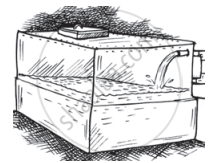Advertisements
Advertisements
प्रश्न
A cubical box has each edge 10 cm and another cuboidal box is 12.5 cm long, 10 cm wide and 8 cm high.
(i) Which box has the greater lateral surface area and by how much?
(ii) Which box has the smaller total surface area and by how much?
उत्तर
(i) Edge of cube = 10 cm
Length (l) of box = 12.5 cm
Breadth (b) of box = 10 cm
Height (h) of box = 8 cm
Lateral surface area of cubical box = 4(edge)2
= 4(10 cm)2
= 400 cm2
Lateral surface area of cuboidal box = 2[lh + bh]
= [2(12.5 × 8 + 10 × 8)] cm2
= (2 × 180) cm2
= 360 cm2
Clearly, the lateral surface area of the cubical box is greater than the lateral surface area of the cuboidal box.
Lateral surface area of cubical box − Lateral surface area of cuboidal box = 400 cm2 − 360 cm2 = 40 cm2
Therefore, the lateral surface area of the cubical box is greater than the lateral surface area of the cuboidal box by 40 cm2.
(ii) Total surface area of cubical box = 6(edge)2 = 6(10 cm)2 = 600 cm2
Total surface area of cuboidal box
= 2[lh + bh + lb]
= [2(12.5 × 8 + 10 × 8 + 12.5 × 10] cm2
= 610 cm2
Clearly, the total surface area of the cubical box is smaller than that of the cuboidal box.
Total surface area of cuboidal box − Total surface area of cubical box = 610 cm2 − 600 cm2 = 10 cm2
Therefore, the total surface area of the cubical box is smaller than that of the cuboidal box by 10 cm2.
APPEARS IN
संबंधित प्रश्न
Find the height of a cuboid whose base area is 180 cm2 and volume is 900 cm3?
Water is pouring into a cubiodal reservoir at the rate of 60 litres per minute. If the volume of the reservoir is 108 m3, find the number of hours it will take to fill the reservoir.

Find the ratio of the total surface area and lateral surface area of a cube.
Three equal cubes are placed adjacently in a row. Find the ratio of total surface area of the new cuboid to that of the sum of the surface areas of the three cubes.
A cuboidal wooden block contains 36 cm3 wood. If it be 4 cm long and 3 cm wide, find its height.
How many bricks each of size 25 cm × 10 cm × 8 cm will be required to build a wall 5 m long, 3 m high and 16 cm thick, assuming that the volume of sand and cement used in the construction is negligible?
A rectangular field is 70 m long and 60 m broad. A well of dimensions 14 m × 8 m × 6 m is dug outside the field and the earth dug-out from this well is spread evenly on the field. How much will the earth level rise?
If the volumes of two cubes are in the ratio 8: 1, then the ratio of their edges is
If the sum of all the edges of a cube is 36 cm, then the volume (in cm3) of that cube is
Find the volume and the total surface area of a cuboid, whose :
length = 15 cm, breadth = 10 cm and height = 8 cm.
